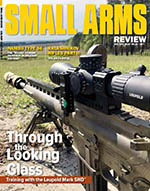Trijicon RMR MP5 Rear Sight Mount
By Alton P. Chiu
Low-Profile, Lightweight, Co-Witnessed
The Heckler & Koch MP5 burst into prominence with the 1980 Special Air Service hostage rescue at the Iranian Embassy in London. It has since filled the armories of various law enforcement agencies, militaries and private citizens. While the passage of time has not diminished its utility in close quarters, it could do with a mounting upgrade to better exploit modern CQB optics such as red dot sights.
The mount available from HKParts.net (SKU: HKP-18234) provides a Trijicon RMR-specific interface designed to achieve absolute co-witness with the standard front sight post. It is lightweight and low-profile to retain the MP5’s ease of use.
Impetus
Electro-optics, such as red dot and holographic sights, provide measurable improvements over iron sights. However, the traditional MP5 optics mount (situated just aft of the ejection port) leaves room for improvement. The shorter cocking tube of the K model places the charging handle too close to the optic. This inadequate access complicates the “HK slap” and increases the likelihood of smudging the optic front lens during magazine changes. Furthermore, the optic mounts at an inconvenient height; it is too tall to maintain the compact profile of the MP5 but not tall enough to clear the front sight hood. A low mount is desirable to maintain cheek weld, but that leaves the top one-third of the front sight hood visible. A mount with lower one-third co-witness for AR-15 pattern rifles will clear the front sight hood, but that gives a tall profile, top-heavy handling and a marginal cheek weld.
While some optics and mount combinations can allow iron sight usage through the lower part of the view window, it requires a shift in head position. This induces an extra delay, which can be detrimental in close quarters. While modern electro-optics are considered reliable enough to entirely supplant iron sights (as has been done, for example, on the Swedish Ak 4B and 4C), they can still suffer reticle “washout.” The reticle can be lost when looking into a bright area with the reticle adjusted for dim conditions, such as when activating a flashlight inside a dim building interior. In such instances, it is desirable to have the optic in absolute co-witness with the iron sights (that is, the reticle rests atop the front sight post when centered in the view window). This enables the user to employ the optic housing as an aperture rear sight to deliver reasonable accuracy without delay.
The RMR rear sight replacement mount achieves this lofty goal with ease. As well as its low profile allowing absolute co-witness and preserving the non-snag nature of the MP5, its rear location keeps it clear of the charging handle.
Physical Description
The black anodized aluminum mount weighs 23 grams (56.5 grams with a Trijicon RM07 and CR2032 battery). This compares favorably with the standard MP5K rear iron sight that weighs 39.6 grams and an MKE claw-type 1913 rail mount that weighs 93.7 grams. Measuring 6.7cm long, 2.9cm wide and 1.0cm tall, the mount and RMR combination only increases the overall height by 1.4cm relative to the standard rear iron sight.
To install the mount, the rear iron sight is first removed by undoing the Phillips screw and locking washer at the rear, while taking care to preserve the windage adjustment screw. The RMR mount is then placed in its stead, although the author found the fit tight enough to warrant a rubber mallet. The aforementioned Phillips screw is replaced by a countersunk 3mm Allen screw. It should be noted that a 5/16-inch Allen key is required for the screws securing the RMR sight to the mount. The author found the installation quick and easy.
Shooting Evaluation
The mount did not present any complications in comparison with the standard iron sights. The unchanged cheek weld and eye position facilitate an easy transition. To quantify the improvements, a test was conducted; the author fired one shot at a target 10 meters distant from low ready within 1.5 seconds. Ten replicates were performed for three sighting methods: using the standard notch iron sights of the MP5K, the rear sight replacement mount with a 6.5 MOA RMR and, lastly, with the RMR off to simulate a failure scenario, in which the view window is used as a makeshift aperture sight.
As expected, the electro-optic notably improved accuracy over the iron sights by removing sight radius as a factor and by reducing the effects of sight alignment error. The author also subjectively noted that sight picture acquisition was faster.
The simulated failure scenario—with the RMR turned off—yielded marginally acceptable accuracy from the MP5. The vertical dispersion is slightly less than the lateral dispersion, and this is because the author learned to index the hole below the front sight hood (for the roll pin securing the front sight post) to be just above the bottom edge of the RMR view window, while there were no such cues for lateral alignment. This result illustrates the advantage of absolute co-witness, should one encounter optic failure or reticle washout: One can still achieve acceptable accuracy at “bad breath” distances.
Conclusion
The RMR MP5 rear sight mount provides an elegant solution for mating a premier electro-optic to a venerable warhorse. Its lightness and low profile deliver measurable accuracy improvements without impeding handling. Absolute co-witness is delivered while both maintaining a familiar cheek weld and allowing the RMR housing to function as a makeshift aperture sight in case of failures. This mount is a worthy accessory in updating the iconic MP5 for the 21st century.
This article first appeared in Small Arms Review V22N7 (August 2018) |
| SUBSCRIBER COMMENT AREA |
Comments have not been generated for this article.






